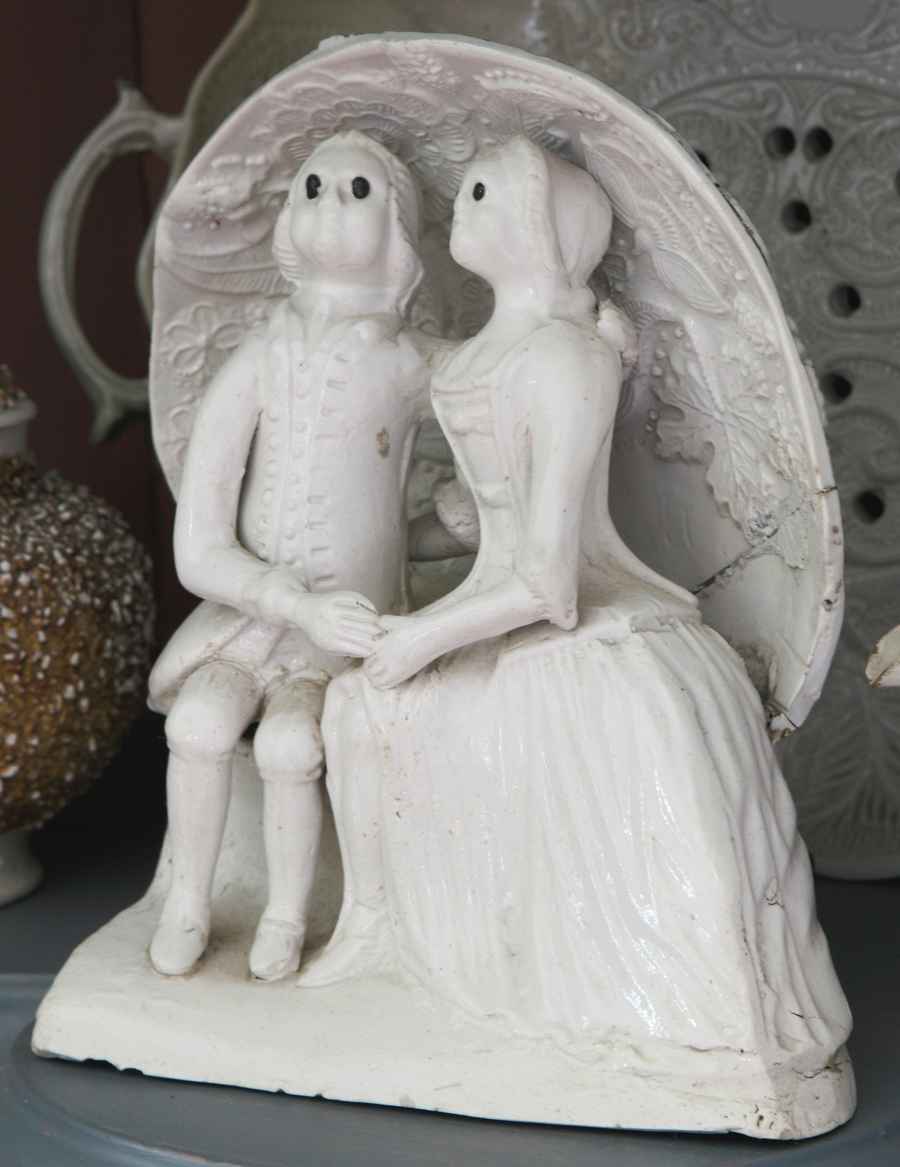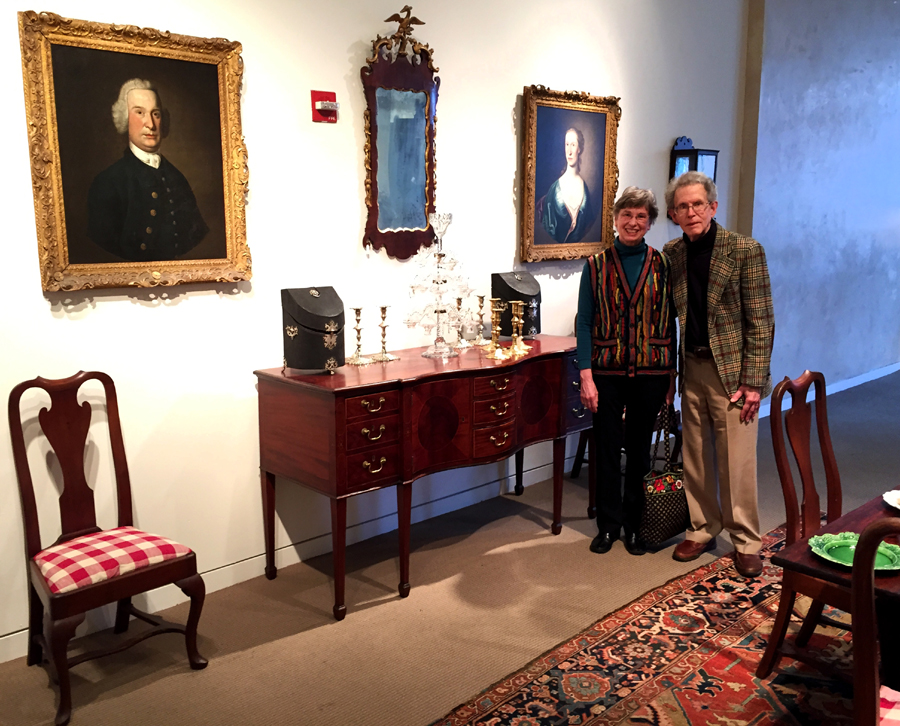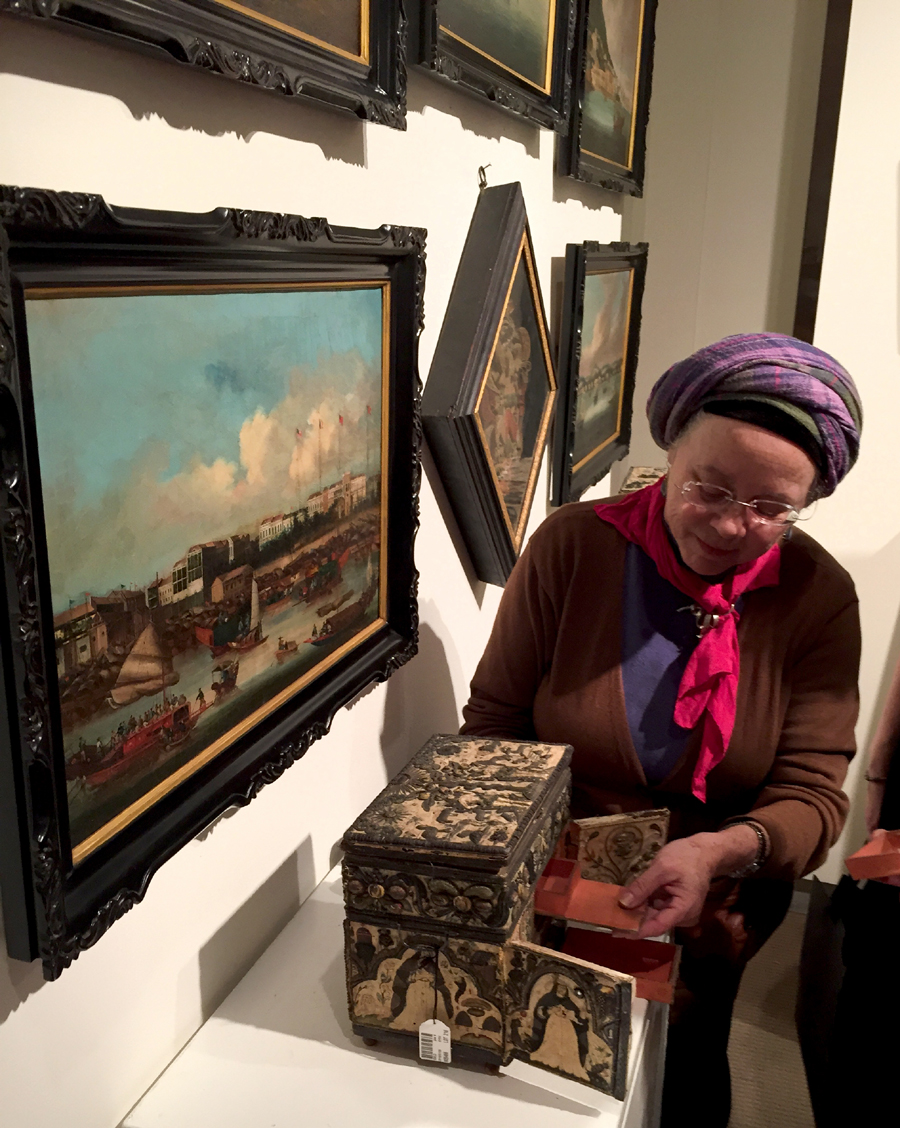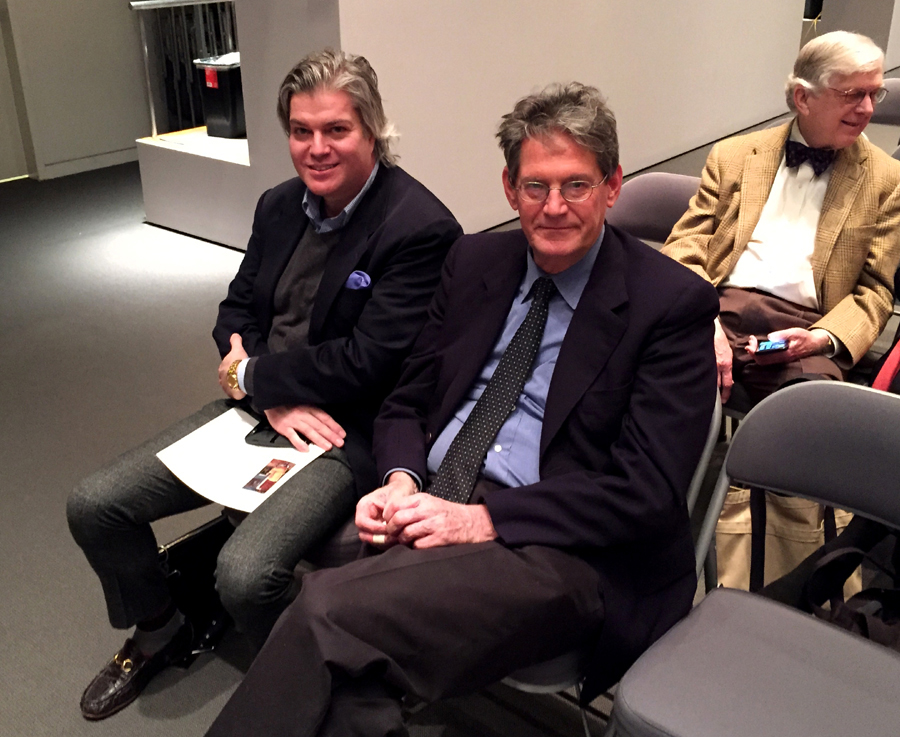By Laura Beach
NEW YORK CITY — Landmark single-owner sales, like that of property from Irvin and Anita Schorsch’s Hidden Glen Farms, auctioned by Sotheby’s between January 20 and 22 for $10,262,129, serve several purposes. They refresh and stimulate the market by returning objects to circulation, rally the collecting community, recalibrate prices and plant flags in the field’s historical timeline. The best single-owner sales become the stuff of legend.
Though the Schorsch sale fell just short of legend, it was a big deal, as Sotheby’s 608-page catalog, now a collector’s item, confirms. The couple collected with a passionate interest in and eye toward history. Having plucked pieces from the collections of Christie, Taradash, Robb, Garbisch, Little, Chorley and other storied hunters, they join the pantheon themselves. As Winterthur curator emeritus Charles Hummel and others suggested at a daylong symposium at Sotheby’s on January 18, Hidden Glen Farms, the couple’s estate in Meadowbrook, Penn., was itself a little Winterthur, right down to a cast-iron figure of George Washington similar to one owned by Henry Francis du Pont. Together with a Mott Ironworks figure of Columbia, the Washington figure realized $22,500 ($10/15,000). Out of nearly 1,050 lots in the Schorsch sale, 12 realized $100,000 or more, 27 brought $50,000 or more, and every lot sold.
Irvin Garfield Schorsch Jr (1927–2014) and his wife, Anita (1930–2015), began collecting in the 1960s as a way of furnishing their 1930s stone farmhouse, designed by G. Edwin Brumbaugh (1890–1983). They gathered Seventeenth through early Nineteenth Century furniture, paintings, prints, ceramics, glass, metalwork, textiles and needlework, accenting the mostly American trove with English, Dutch and Chinese pieces. Academically inclined, they were drawn to unusual things and, to their credit, were willing to overlook condition issues when objects had interesting stories to tell.
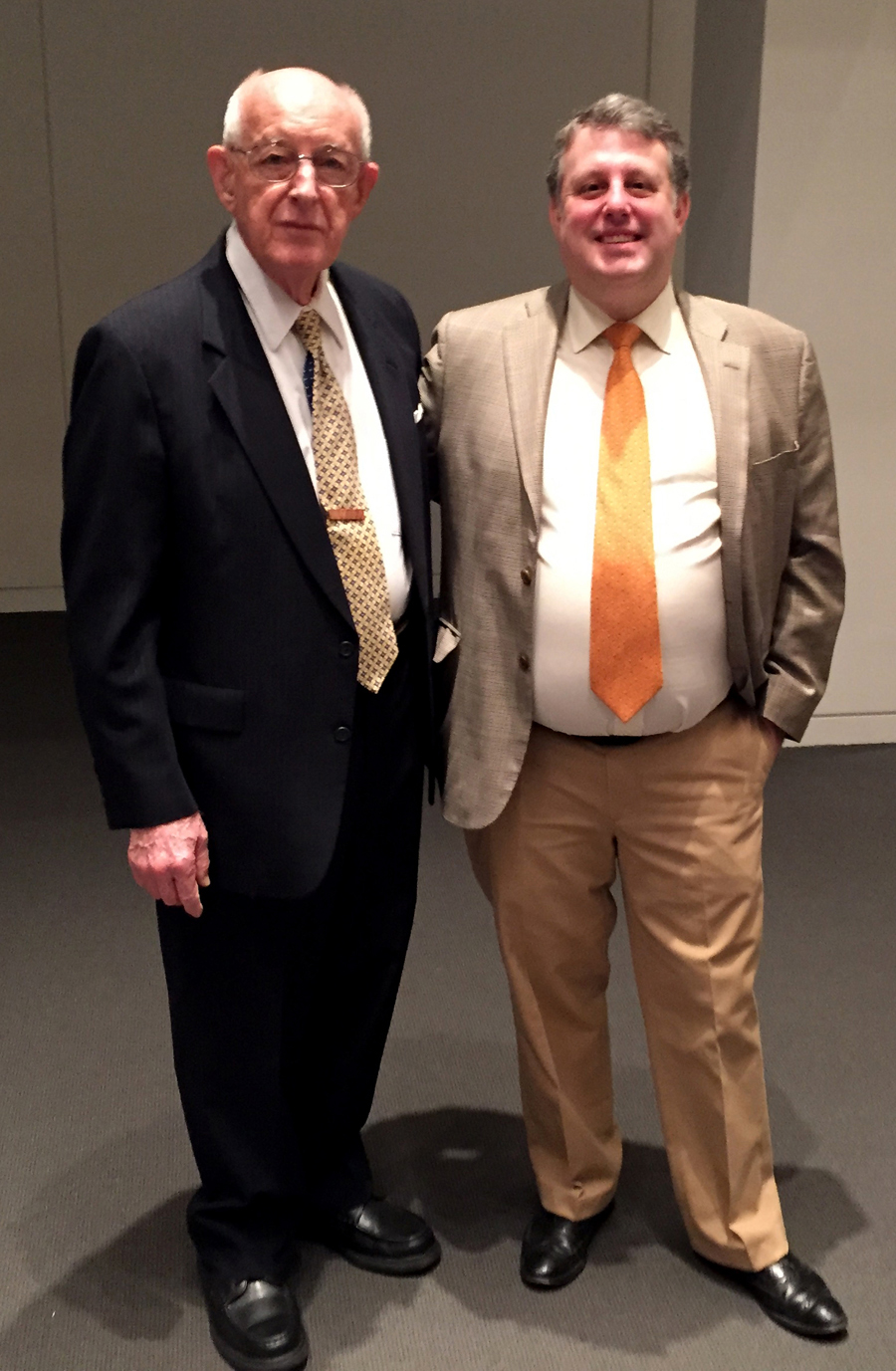
Charles F. Hummel, curator emeritus and adjunct professor at Winterthur Museum, and Sotheby’s Americana head Erik Gronning before the symposium.
Devoted partners, husband and wife passed their love of collecting to their three sons: Irvin III, Peter and Nicholas. Nick and his wife, Shelley, are among the most active collectors of American art, fine and decorative, and classic cars in the country. They restored and furnished Mount Pleasant Plantation in Spring Grove, Va., and are working on Hopedene mansion in Newport, R.I., where they co-founded the Audrain Automobile Museum.
“The sale overall was a tremendous success because the collection was offered unreserved. That allowed people with a great diversity of interests to participate and guaranteed that everyone had a chance to buy, a strategy that prompted spirited bidding. While the market is not as high as it once was, there were many strong, successful results,” said Erik K. Gronning, head of Sotheby’s Americana department.
“A private collector got an exceptionally fine piece for a very fair price,” Gronning said of the sale’s top lot, the Burnham-Manning family bombe bonnet-top chest on chest, $970,000. Gronning was likewise pleased that a circa 1770 Philadelphia Chippendale dressing table associated with the Garvan carver also went to a private collector, for $150,000.
Offering more than a thousand lots without reserve meant opening bidding at ten percent of estimate, reducing the rate of sale to about 50 lots an hour. Sotheby’s regularly announced that “interested parties” — meaning the couple’s children — might participate. The slow pace coupled with aggressive phone bidding by what the audience assumed, without confirmation, to be “interested parties” irritated some prospective buyers. Others were sanguine. As one dealer reminded, “The family could have reserved everything, which would have eliminated any chance of bargains. This was the first time I’ve seen Sotheby’s sell lots for $50.”
“It’s an exciting auction with a wide disparity in values. Smaller objects and silver are doing well. Brown furniture is inconsistent. I got a few treasures. I hope that other family members picked up some things of sentimental interest,” Irvin Schorsch III told Antiques and The Weekly before the start of the third session.
A longtime collecting couple waited patiently for a Staffordshire agateware scent bottle and stopper and were delighted when it was knocked down to their paddle. Five minutes later, they were astounded when Sotheby’s reopened the lot without explanation. “I’ve never seen a lot resold after it was hammered down. We knew Anita and Irvin for years and enjoyed spending time with them. Anita was a great lady, a person of honor. She would have been horrified by what happened,” said the husband.
Complaints aside, those who attended Sotheby’s January 18 symposium were treated to talks by curators and other specialists who worked with the couple over many years.
“They were exceptional collectors and an exceptional couple,” said Hummel, a longtime friend who advised the Schorsches professionally for a time in the 1960s, before they were “seasoned collectors” who mainly sought his help with research.
“I first knew Irvin and Anita in the 1970s and began doing upholstery for them 15 or 16 years ago. They had any number of things that don’t fall into known, documented categories,” said furniture consultant Robert F. Trent, ticking off items of special interest: among others, a red painted circa 1730 Massachusetts chest of drawers with lively freehand vine and flower decoration, $50,000; a rare Anglo Dutch hanging glass cupboard, $6,250; William and Mary joined armchairs covered in period Russia leather, $20,000 and $16,250; and a carved and painted blanket chest, $7,500, possibly made by William Searle in Devon, England, around 1670.
Hummel and his colleague Don Fennimore, curator emeritus of metals at Winterthur, noted Irving Schorsch’s love of clocks. Standing out among roughly two dozen examples was the Lewis Family tall-case clock, $162,500, a strikingly early Philadelphia example of about 1730. Fennimore most admired the couple’s collection of base metals, much of it displayed by the hearth in their keeping room.
Sotheby’s silver specialist John Ward likened silver in the Eighteenth Century to today’s 60-inch flat-screen television: “You set it out so your friends could admire it.” The Schorsches, he noted, mixed American and English pieces in a way that, although unusual for collectors today, was typical of affluent Americans of the period. The Schorsches owned 16 silver tankards, he said, and may have had Yale’s great John Coney monteith in mind when they purchased an English example, resold for $32,500, of about the same date.
Most of the paintings were portraits. The top lot, a pair of likenesses, $274,000, by Ralph Earl, depicted the Connecticut couple Jared and Apphia Ruggles Lane. Laura Barry, the Juli Grainger curator of paintings, drawings and sculpture at Colonial Williamsburg, noted the depth and nuance of the Schorsch collection.
“These are the kinds of stories that bring objects and collections alive,” said Barry, noting the couple’s talent for pairing objects. She gave as an example John Greenwood’s portrait, $16,250, of Reverend John Moorhead of Arlington Street Church and a pair of silver canns, $2,500, from the same Boston church.
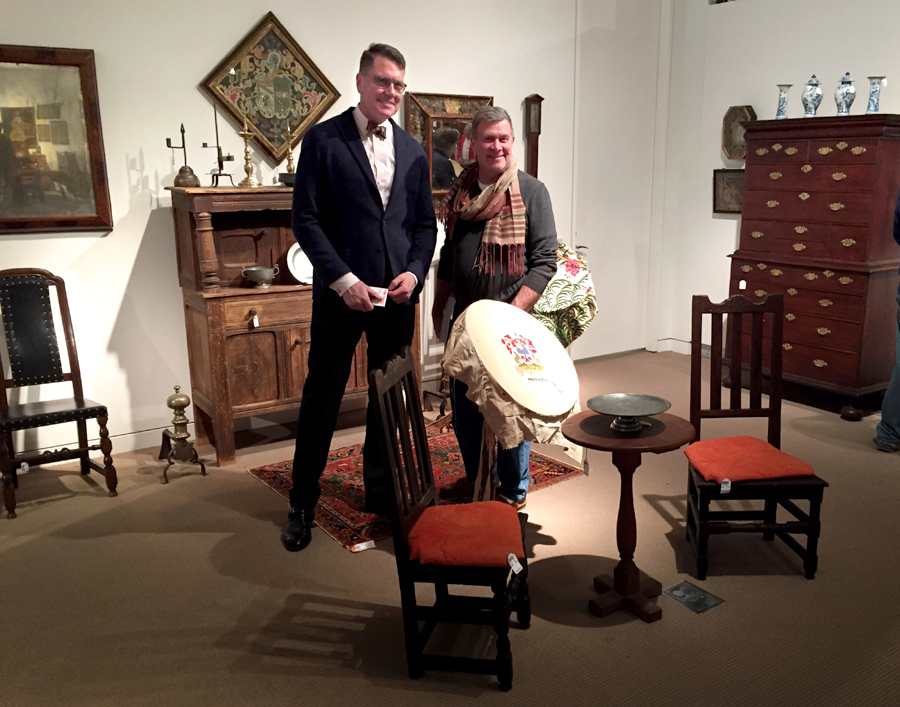
Designer Thomas Jayne, left, and his husband, Rick Ellis, at the preview. On the wall behind them is an Eighteenth Century New England coat of arms, $27,500 ($15/$25,000).
“Any collection is about the people. Otherwise the stuff is just stuff,” Ceramics in America editor Robert Hunter said, noting the couple’s interest in the theme of lovers, both Adam and Eve and courting couples. Hunter counted at least five Adam and Eve delft chargers, the most he had ever seen in a private collection. He spoke at length about one of his favorite pieces, a Leeds creamware jug, $81,250, containing “a wealth of information on decorative and social practices.” One side of the jug shows women identified as Elizabeth and Mary taking tea, the other side features men labeled William and Joseph drinking wine. “This is the duality of the Eighteenth century, punch and tea. Society needed both for balance,” noted Hunter.
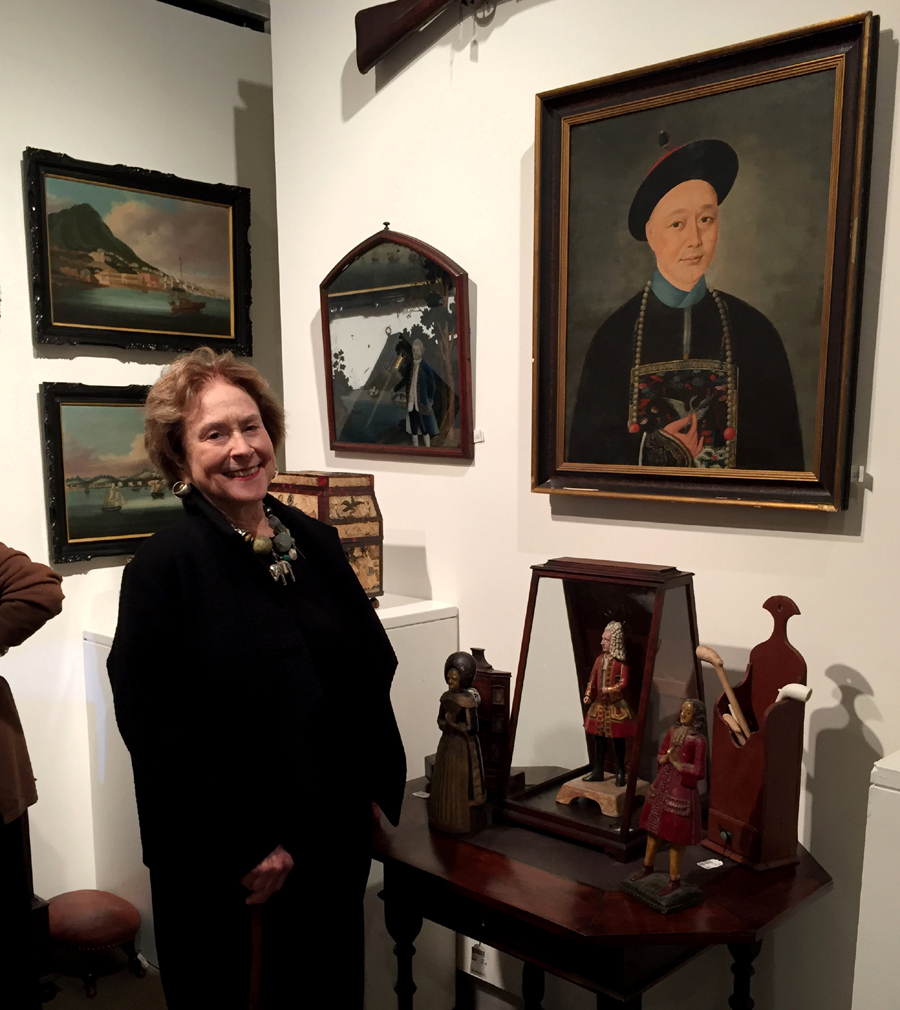
Historian Elizabeth Stillinger with the oil on canvas portrait of a Hong merchant by Spoilum (active 1770–1805), $32,500 ($40/60,000), deaccessioned by the Abby Aldrich Rockefeller Folk Art Museum in 1958.
“She loved embroideries only second to Irvin,” said Tricia Wilson Nguyen, a needlework expert who found a kindred spirit in Anita. Nguyen spoke rivetingly about early English embroidered caskets, an intriguing blend of women’s domestic handicraft and commercial production. One, a James I example dating to the first quarter of the Seventeenth Century, achieved $40,000.
Hummel also noted Anita’s “strong affinity for textiles.” Of an important Boston filigree hanging wall sconce, $125,000, of circa 1730, he said, “It wasn’t an object that excited Irvin, but Anita knew it was rare and she convinced Irvin that they had to acquire it.”
Anita Schorsch, whose doctoral degree was from Princeton, wrote Mourning Becomes America: Mourning Art in the New Nation. Her sensitivity to an expertise in mourning art was reflected in outstanding prices for memorializing jewelry and needlework. Alessandra Merrill, a cataloger in Sotheby’s silver department, said it was a treat to handle the jewelry, citing the auction’s last two lots: a gold brooch, $47,500, and a ring, $30,000, both said to contain strands of George Washington’s hair.
About the hair, Merrill remarked, “There’s no way to prove it but the provenance is very good.”
The Schorsches also amassed an important library, containing what Hummel called “the best privately owned collection of emblem books in the United States.” Sotheby’s will auction printed materials in June.
Sotheby’s is at 1334 York Avenue in New York. For further information, 212-606-7000 or www.sothebys.com.
Gallery
[slideshow_deploy id=’1000261946′]
